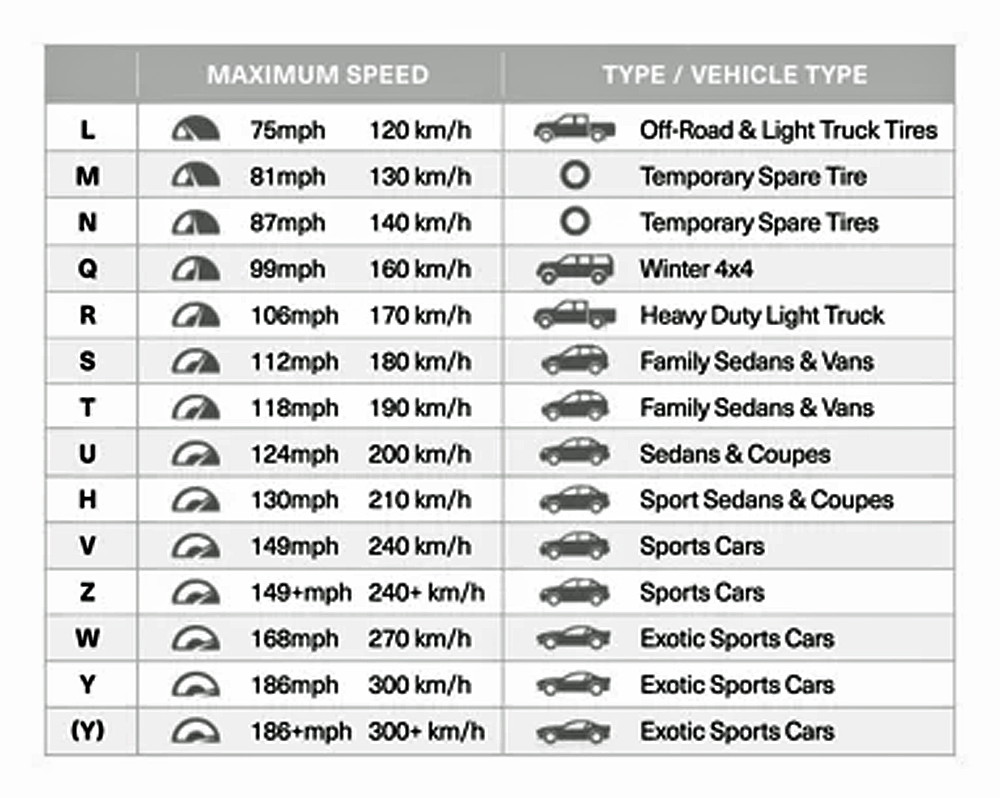TIRE/TYRE SPEED RATINGS
by GoMoG
What They REALLY Mean
SPEED RATINGS REFER TO MORE THAN JUST SPEED!!!! Contrary
to their name, speed ratings are also about
ride comfort, wear and cornering ability.  Typically, the higher the
speed rating, the better the grip and stopping power, but the lower the
tread life. You can always increase the speed rating of the tires on
your vehicle for improved performance, but you can never decrease it
without reducing the vehicle top speed to that of the lower speed
rating selected, while enduring less comfort and handling ability.
Typically, the higher the
speed rating, the better the grip and stopping power, but the lower the
tread life. You can always increase the speed rating of the tires on
your vehicle for improved performance, but you can never decrease it
without reducing the vehicle top speed to that of the lower speed
rating selected, while enduring less comfort and handling ability.
And
though I can assure every one of you that any trad Morgan can be
tweaked and tuned by YOU to have the most sublime suspension and
confort you have ever experienced, the most significant suspension
component in a Morgan suspension is the tyres you put on it. Tyre
sellers and manufacturers will tell you simply to match the speed
rating you have, but it is NOT their hobby, it is yours! The
difference, for any Morgan, between a cheaper rating and a better one
is very significant. Any mogger with a rating lower than "H" is missing
a LOT OF FUN and added safety. I use a minimum of a "V" rating and
prefer "W". Yes, better tyres will not last as long, but there is no
extra cost that is expensive considering the added joy you get. When
the Factory delivered me a car with "H" rated tyres, I swapped them out
three days after and was thankful I did so. (I gave them to my
daughter's boyfriend of the day who I didn't like!)
The reasons behind this fact should be obvious. The quality of the
rubber improves with the higher the rating. To make a tyre last a long
time, additives are used. These long life additives make the rubber
harder, less road compliant, less comfortable. They cut into your fun.
When I see moggers with cheaper tyres I feel bad for them. Every mogger
I convince to upgrade their rubber has the same reaction. They are angry at themselves that they took so long to do so.
History of Speed Ratings
Thank Germany’s famous Autobahns for tyre speed ratings. They became
logical in that environment and we should all be happy for it.
Tyre speed ratings range from A (the lowest) to Y (the highest). But
the chart is not completely in alphabetical order. For example, H is
between U and V, with the common perception that H stood for “high
performance” at one time. As manufacturers continue to add speed
to their vehicles, tyre speed ratings evolve to match the speeds. For
example, Z was the highest rated speed at 149+ until W & Y were
used to match the higher speeds of exotic sports cars.
Mixing Speed Ratings
Don’t.
But if tyres of different speed ratings are mounted on a vehicle, the
lower speed-rated tyres should be placed on the front axle regardless
of which axle is driven. This is to prevent a potential oversteer
condition. Vehicle handling will also be affected, and the vehicle’s
speed capacity is now limited to the lowest speed-rated tyre. For best
performance, it is recommended that the same size, type of tyre and age
be used on all four wheel positions.
Load Index
The load index (99) is the tyre size's assigned numerical value used to
compare relative load carrying capabilities PER TYRE!!! The higher the
tyre's load index number, the greater its load carrying capacity and
the less compliant it will be.
97 = 1,609 pounds
98 = 1,653 pounds
99 = 1,709 pounds
A tyre with a
higher load index than that of the Original Equipment tyre indicates an
increase in load capacity. A tyre with a load index equal to that of
the Original Equipment tyre indicates an equivalent load capacity. A
tyre with a lower load index than the Original Equipment tyre indicates
the tyre does not equal the load capacity of the original. Typically, the load indexes of the tyres used on passenger cars and light trucks range from 70 to 110. With a hyper-light Morgan, I go for the lowest load index I can find subject to the desired Speed Rating.
 Typically, the higher the
speed rating, the better the grip and stopping power, but the lower the
tread life. You can always increase the speed rating of the tires on
your vehicle for improved performance, but you can never decrease it
without reducing the vehicle top speed to that of the lower speed
rating selected, while enduring less comfort and handling ability.
Typically, the higher the
speed rating, the better the grip and stopping power, but the lower the
tread life. You can always increase the speed rating of the tires on
your vehicle for improved performance, but you can never decrease it
without reducing the vehicle top speed to that of the lower speed
rating selected, while enduring less comfort and handling ability.